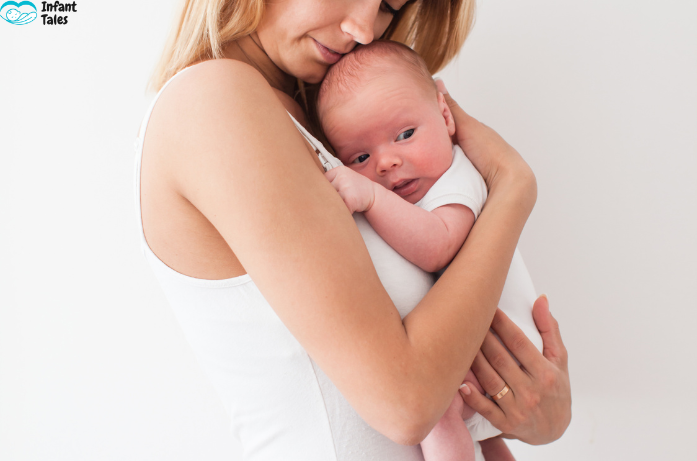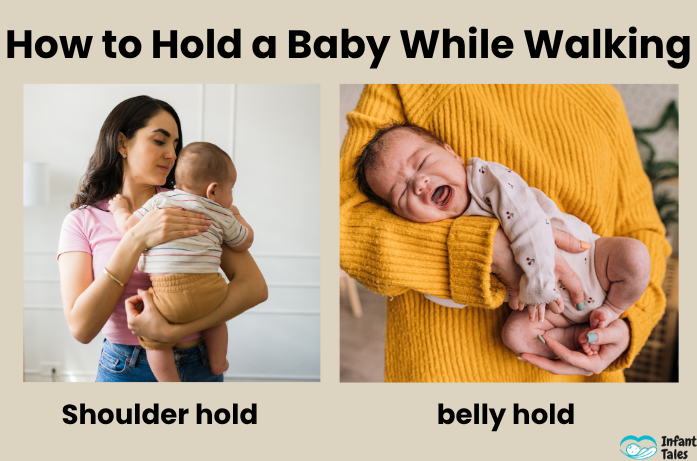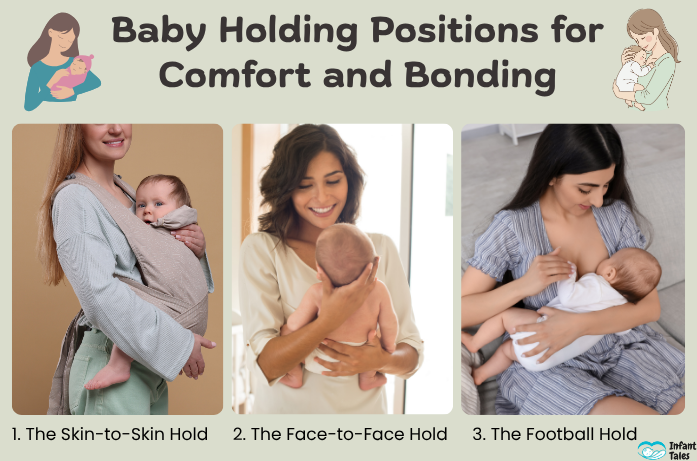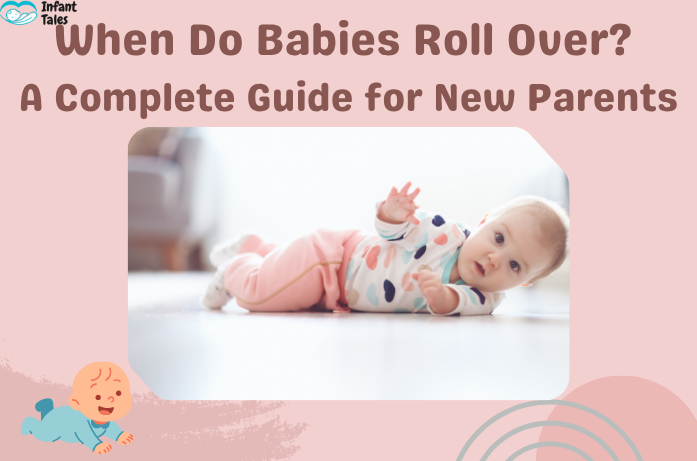By a Caring Mom at Infant Tales
Holding your baby is one of the most precious moments of parenthood. It’s a comforting and magical feeling to hold your little one in your arms and feel a bond stronger than ever before. However, this is not only a blessing but also a source of concern for many new parents, especially when it comes to how to hold a baby correctly.
Newborns are very small and delicate, with very little muscle strength, so they need to be handled safely and comfortably, so learning the correct way to hold a baby is crucial. Your baby’s comfort, safety, and connection to you depend on your technique, whether you’re standing, sitting, or walking.
Why Holding a Baby Properly Is So Important
Babies can’t support their heads on their own during the first few months because their neck muscles are still developing. Improper latching can put pressure on their neck, cause discomfort, or even cause injury. However, the benefits of latching go beyond safety; it can help you:
- Through proximity and touch, a strong emotional bond will be formed.
- Calm your baby during fussy or crying moments.
- Make feeding, burping, or soothing easier.
- Help the baby feel loved, warm and safe.

1. How to Hold a Baby While Standing
Standing and holding your baby is a natural thing for every single parent, whether it is for comforting a crying baby, rocking them to sleep or moving around the house. The important point is that your little one should be both safe and comfortable.
Step 1: Always with one hand support your baby’s head and neck. A newborn’s neck muscles are still developing so this support is very important.
Step 2: Step 3: Now, use your opposing hand to prop up the back and bottom whilst keeping their body in the same natural alignment as your chest.
Step 3: Keep the baby close to your chest in such a way that they can feel your heartbeat. The infants cling to the warmth, trust, and security of this closeness, just like the comfort they recall from the womb.
Step 4: Stand tall and balanced, shoulders relaxed and feet slightly apart. Do not lean back or keep your baby too distant from you.
For extra comfort try to sway or bounce gently while you hum softly. Babies are fond of rhythm, it calms them and it gives the emotional bond between you and your little one a stronger feeling.

2. How to Hold a Baby While Sitting
Sitting and holding a baby is one of the safest and most pleasant methods to establish a bond, particularly for new mothers who are recovering from postpartum or for grandparents who are playing with their little ones.
Step 1: Make sure you are sitting in a comfortable chair with your back supported and feet flat on the floor to create a stable base.
Step 2: The cradle hold is one of the options, place your baby’s head in the bend of your arm and let the rest of their body lie on your forearm. Your other arm can be used to support the back and bottom of the infant. This posture is great when you are breastfeeding, comforting or singing lullabies.
Step 3: The lap hold is perfect for nurturing, put your baby on your lap facing you and hold the head and back while talking or smiling at them. This technique develops early communication and trust.
Step 4: When changing your baby’s position do it slowly and gently so as not to compromise safety.
For long holds, you can use a small pillow under your arm for extra support. It alleviates shoulder tension and keeps you relaxed while having your baby cuddled next to you.

3. How to Hold a Baby While Walking
Walking with your baby in your arms is a wonderful way to calm, soothe, and bond with the child. Your little one will feel secure and loved because of the soft movement and heat from your body.
Step 1: Always keep one hand supporting your baby’s head even while walking especially for the newborns.
Step 2: Shoulder hold try it, place your baby upright on your shoulder with one hand under the head and the other under the bottom. This is perfect for burping your baby after feeding, and it also allows you to have close skin contact.
Step 3: For gassy or colicky babies, the belly hold is a miracle. Lie your baby face-down on your forearm, with their head close to your elbow and your hand under their tummy and legs. It gently eases trapped gas and discomfort from colic.
Walk slowly, talk in whispers, and enjoy these quiet walks, as these are moments that promote both relaxation and connection.

4. Baby Holding Positions for Comfort and Bonding
Holding your baby is one of the loveliest experiences of early parenthood. Here are four unique holding positions that not only provide comfort but also foster emotional connection and relaxation:
1. The Skin-to-Skin Hold
Put your baby right on your bare chest and cover both of you with a light blanket. This is called kangaroo care and it has been shown to help with the regulation of your baby’s temperature, heartbeat, and breathing. Moreover, it fortifies the emotional bond.
2. The Face-to-Face Hold
Take a seat and position your baby so that he/she is looking at you. Support their back and neck while talking or gently singing. The infants love to watch faces and it is a great way to build their emotional consciousness and trust.
3. The Football Hold
This method is generally employed in conjunction with breastfeeding. Support the baby’s head and neck with your hand while positioning the baby under your arm (as you would hold a football). This is great for moms recovering from C-sections as it avoids pressure on the abdomen.
4. The Reclined Hold
Slightly lean back and put your infant on your chest. Allow them to sleep well and support their body gently. This pose is great for connecting, particularly during quiet snuggling time.
5. Common Mistakes to Avoid When Holding a Baby
Without realizing it, even the most caring of parents can sometimes make unintentional mistakes. Check out the following list of things to avoid:
- Not supporting the neck or back of the baby well.
- Holding the baby at a distance from your chest (it feels insecure for the baby).
- Jiggling or rough rocking.
- Carrying the baby with one hand or doing multiple things counting the baby.
- Neglecting your posture, it can cause back pain and affect balance.
Pro Tip: Always be calm and self-assured to the maximum. Infants pick up on your feelings and if you are relaxed, they will feel secure too.
6. Tips for Safe and Comfortable Baby Holding
- Wash Your Hands: Always put the germs away by washing your hands before touching a newborn.
- Stay Calm: Babies are very sensitive to adult emotions. A calm parent will definitely help a fussy baby.
- Use a Baby Wrap or Carrier: Ensure the baby’s face is visible and not covered by fabric.
- Check for Support: If the baby is going to be taken by someone, ensure that person is sitting down or is stable.
- Sudden movements should be avoided: Babies are very sensitive to sudden movements. Therefore, it is better to slow down your movements and speak softly.
7. When to Ask for Professional Guidance
If you ever have doubts about the right way to hold your baby, especially if your baby has some medical conditions, was born prematurely, or has muscle weakness, do not hesitate to ask your pediatrician or a childcare specialist professional for advice.
Final Thoughts
You get connected through holding your child which is one of the easiest yet most important ways. Every cuddle, every soft whisper, and every soothing touch to the baby help him/her to feel secure and loved.
As you try out different baby-holding positions, you will gradually find out what your baby likes best. Remember, there’s no perfect way to hold a baby, only a loving and safe one.
At Infant Tales, we believe that every parent can confidently nurture and comfort their baby with gentle care, patience, and love.
FAQs
Q1. How should I hold my baby for the first time?
Support the head and neck, hold your baby close to your chest, and move slowly.
Q2. Is standing while holding a baby safe?
Yes, as long as you support their neck and hold them securely against your chest.
Q3. When can I hold my baby on my hip?
Usually around 6 months, when your baby can control their head and sit with support.
Q4. What’s the best hold to calm a crying baby?
Try the shoulder hold or belly hold while gently walking and humming.
Q5. Can I bond with my baby through holding?
Absolutely! Skin-to-skin and face-to-face holds are wonderful for bonding.
At Infant Tales, we believe that every cuddle and hold builds a lifetime of trust.
Keep exploring our Baby Care Guides to learn more safe, loving ways to care for your little one.
Disclaimer: This article is for informational purposes only and not a substitute for medical advice. Always consult your pediatrician for personalized newborn care guidance.



